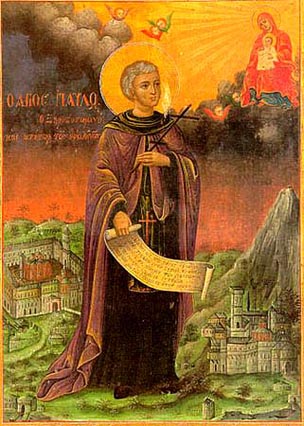
The Monk Paul of Xeropotama
Commemorated on July 28
The Monk Paul of
Xeropotama, in the world Prokopios, was the son of the Constantinople
emperor Michael Kuropalatos, – who afterwards resigned the imperial dignity
and accepted monasticism in a monastery built by him. Having received the
finest education, Prokopios became one of the most learned people of his time.
His "Discourse on the Entrance into the Temple of the MostHoly Mother of
God", the "Canon to the Forty Martyrs", the "Canon to the
Venerable Cross" and other works gained him worthy reknown. But knowledge
and place of honour in the world did not captivate him. Having left everything
worldly, he exchanged his fine garb for beggar's rags, and he went to the Holy
Mountain [Athos], to the place Xeropotama. He built himself a cell there at the
remains of a ruined monastery, founded once by the empress Pulcheria in honour
of the 40 Martyrs, and from Cosmas an hermit he took monastic vows with the
name Paul.
Out of humility the
Monk revealed his learnedness to no one. Fame about the strict life of Paul
quickly spread throughout all the Holy Mountain. He became called Paul of
Xeropotama, and the monastery where he pursued monasticism, to the present day
bears the name Xeropotama ("dry-creek").

At that time there
came upon the throne the emperor Romanos, a relative of Paul. Through the
Protos of the Holy Mountain he requested the saint to come to Constantinople
and made for him a splendid reception. The humble Paul, not betraying his
monastic duty, appeared with a cross and in torn robes amidst the courtly
splendour and magnificence. The Monk Paul confirmed his fame as a chosen of
God, miraculously healing the grievously ill Romanos, by placing his hand on
him. But the vanity of courtly life, promised by the gratitude of the emperor,
did not interest the saint; he returned to the Holy Mountain, having asked of
the emperor but one mercy – to restore the Xeropotama monastery.
At the holy altar in
the consecrated cathedral church of the restored monastery was put a piece of
the Venerable Wood of the Life-Creating Cross of the Lord, given to Saint Paul
by the emperor Romanos.
Soon the Xeropotama
monastery was filled by a throng of monks, wanting to put themselves under the
guidance of the holy ascetic, but the Monk Paul, having entrusted the rule of
the monastery to one of the brethren, moved off to a remote wilderness. His
strict quietude was again disturbed by disciples, not wanting to quit their
elder. Then the monk requested of the emperor the means for the building of a
new monastery. Thus was founded by the saint a monastery in the name of the
holy GreatMartyr and Victory-Bearer Saint George. The first head of the new
monastery was the Monk Paul himself, who there also brought a piece of the Venerable
Wood of the Cross of the Lord.
Having been informed
in advance by the Lord of his impending end, the saint assembled to himself the
brethren of the Xeropotama and the new Georgikos monasteries and gave them his
final directives. On the day of his death, the Monk Paul donned the mantle,
read the prayer of Saint Ioannikes, which he said continually: "My hope –
is the Father, my refuge – is the Son, my protection – is the Holy Spirit,
Holy Trinity, glory to Thee", and he communed the Holy Mysteries of Christ.
Saint Paul had instructed in his will to bury his body on the peninsula of
Pongosa (opposite the Holy Mountain). But by the will of God the ship was
driven to the shores of Constantinople, where the emperor and Patriarch with
the pious took the body of the saint and solemnly placed it in the Great
church. After the sacking of Constantinople by the Crusaders, the relics of
Saint Paul were transferred to Venice.
© 1996-2001 by translator Fr. S. Janos.